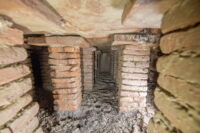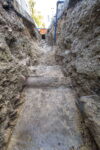 The remains of an underfloor heating system in exceptional condition has been discovered in the remains of a Roman building in Bonn, Germany. Private homes and baths with luxurious hypocaust heating are not uncommon finds in Germany — the upper classes were the first to adopt Roman culture and creature comforts in outlying territories — but this one is unique for its untouched state of preservation. The original floor is still in place over the hollow space, supported by regular pillars of tile (pilae stacks). Usually the floors over hypocaust systems have collapsed and the cavity filled with soil or debris. This is an extraordinary example of an undamaged hypocaust structure that appears, pardon the climate control pun, frozen in time.
The remains of an underfloor heating system in exceptional condition has been discovered in the remains of a Roman building in Bonn, Germany. Private homes and baths with luxurious hypocaust heating are not uncommon finds in Germany — the upper classes were the first to adopt Roman culture and creature comforts in outlying territories — but this one is unique for its untouched state of preservation. The original floor is still in place over the hollow space, supported by regular pillars of tile (pilae stacks). Usually the floors over hypocaust systems have collapsed and the cavity filled with soil or debris. This is an extraordinary example of an undamaged hypocaust structure that appears, pardon the climate control pun, frozen in time.
 The Roman building was unearthed in an archaeological survey at the site of gas and water works. An ancient Roman building was known to be in the area since finds first emerged in the 19th century, so archaeologists excavated the planned rout of the replacement gas and water pipes. Parts of the structure emerged quickly; it was closer to the surface than anyone realized. Three rooms were discovered, and painted wall plaster fragments indicate they were elaborately decorated.
The Roman building was unearthed in an archaeological survey at the site of gas and water works. An ancient Roman building was known to be in the area since finds first emerged in the 19th century, so archaeologists excavated the planned rout of the replacement gas and water pipes. Parts of the structure emerged quickly; it was closer to the surface than anyone realized. Three rooms were discovered, and painted wall plaster fragments indicate they were elaborately decorated.
The documentation of the cavity [in the hypocaust room] turned out to be difficult because it can only be seen through a narrow hole in the Roman floor. With the help of video cameras, it was possible to capture most of the cavity. In order to be able to understand the size of the cavity more precisely, the LVR-ABR carried out a measurement with the georadar. With this method it is possible to identify structures in the ground without the need for excavation. The radar image showed that the underfloor heating was located under a room with an apse. However, the full extent of the room and the heating system cannot be recorded here either, since the conditions on the surface limit the space for measurement.
Excavations at the end of the 19th century and in the 1920s and 1950s had already revealed walls and rooms that belonged to a stately Roman building. The building has so far been interpreted as a Roman country estate, a villa rustica. However, the new findings also make other functions appear possible. “Perhaps we are also dealing with a small bathing facility here, south of the Bonn legionary camp,” says Berthold. In order to be able to say more precisely, the results of the excavation must first be evaluated.
To preserve the hypocaust system in situ, archaeologists will be refilling the cavity using liquid soil, a special material that solidifies in a space but is easy to flush out like a liquid whenever needed. This will prevent the ground from subsiding and the cavity from collapsing, while making the invaluable site readily available for future archaeological explorations.